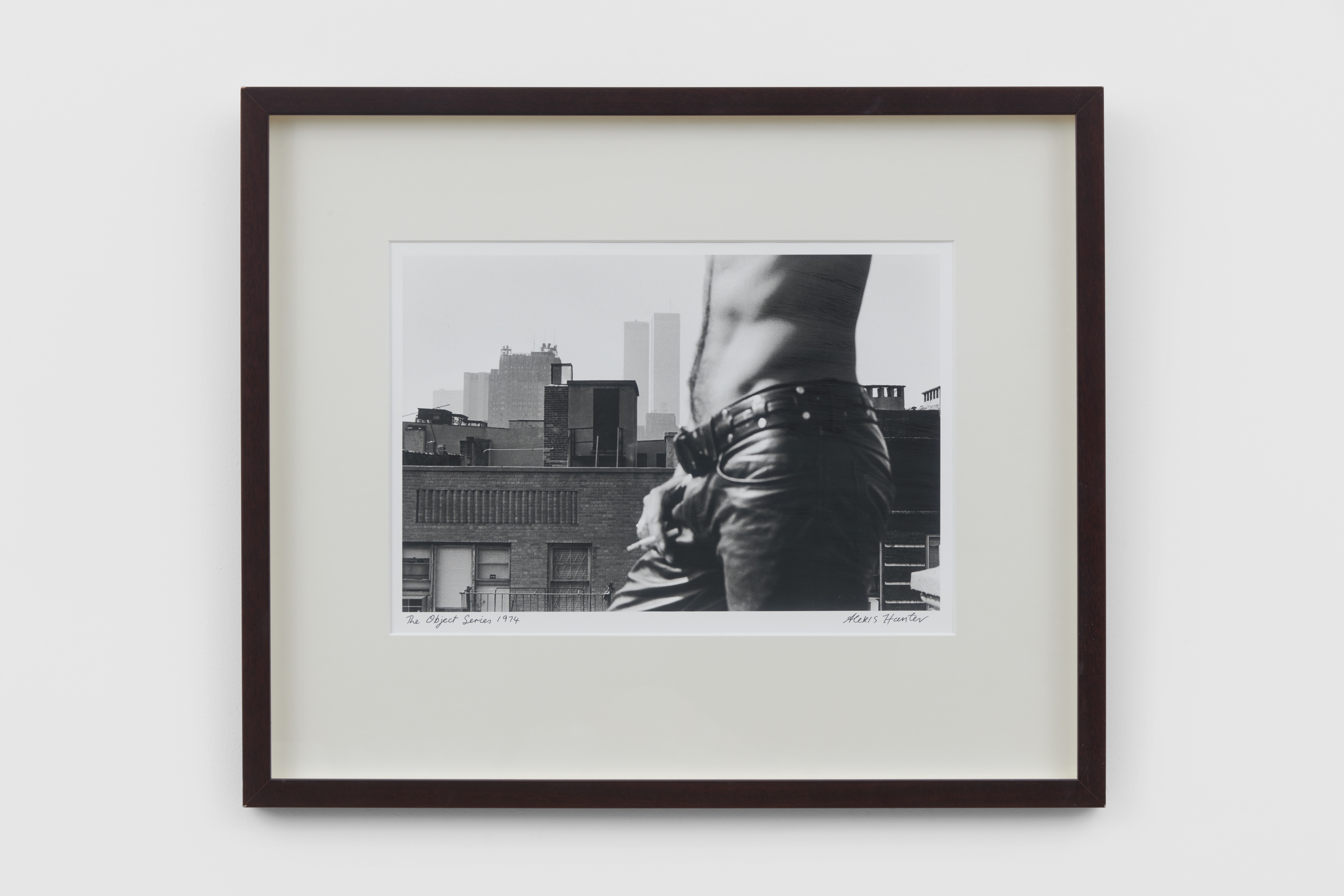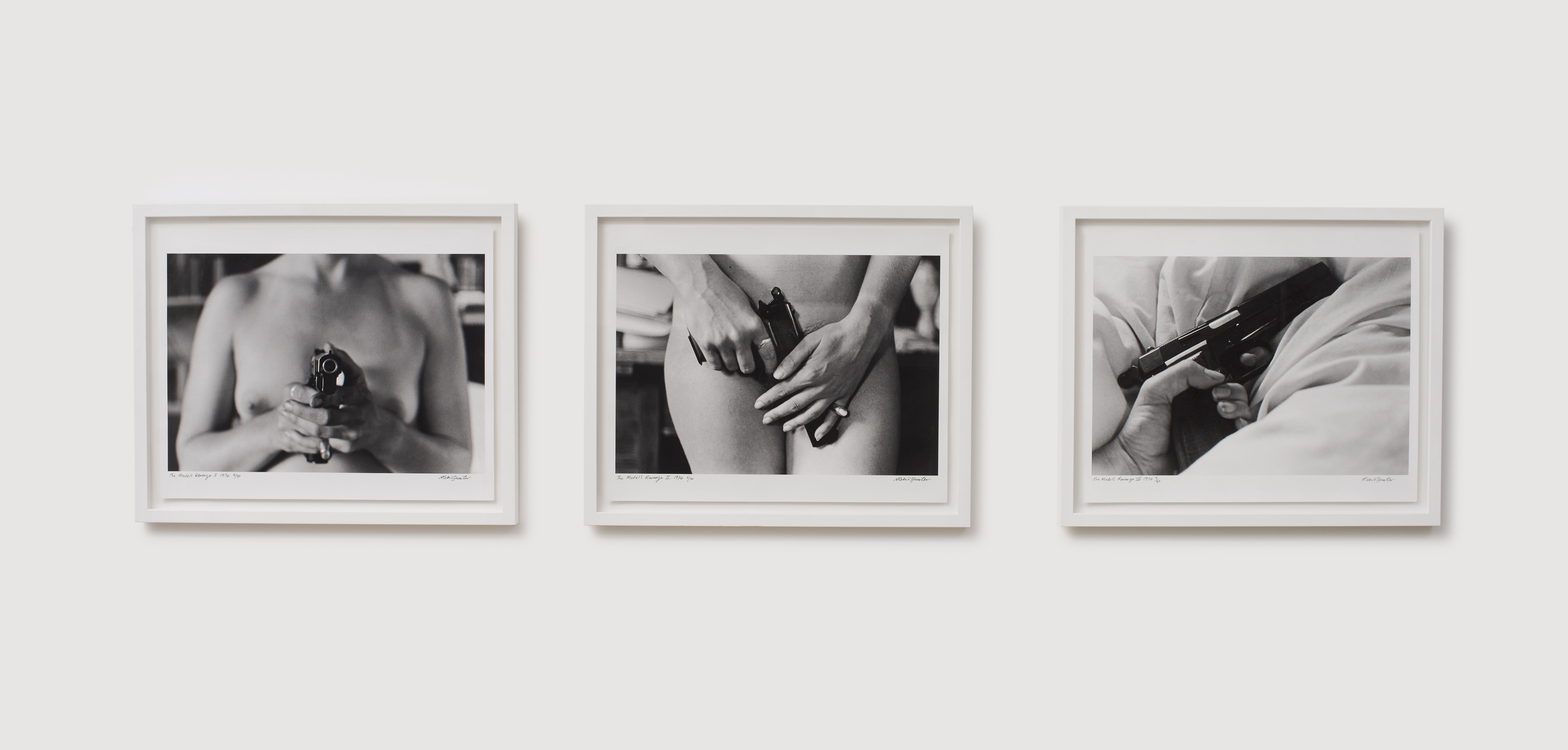
Domestic Warfare (1979), © Alexis Hunter, courtesy Richard Saltoun Gallery
A monochrome female torso, reflected in the segmented mirror of a hotel’s bedroom, makes a self-portrait using an SLR camera, the blurred indentation of a bullet hole hiding in plain sight— a silent reminder of daily life in the United States of America. A montage of images displaying a scene of idealised domesticity, by way of ownerless arms on either side of a dining table, descends into a fit of carnage in which furniture is torn, an axe is thrust through a wall with destructive force and a goldfish bowl is clutched, held on the verge of the perilous. Within another arrangement, the mournful, haunting message “Alone We Failed” is daubed in blood across white tiles, an accompanying glass of red wine, both mirroring and mocking the unsettling sight.
Perhaps the most apt word for the transgressive, sobering, autobiographical works of visual artist Alexis Hunter (1948-2014), as curated by Natasha Hoare (senior curator at Goldsmiths Centre for Contemporary Art, London), and presented at Richard Saltoun, would be confrontational. Whether by way of humour, anger or frustration, Hunter’s works confront oppressive social systems, outdated ideals and even arguably members of her audience, themselves. With the exhibition’s title referencing the durational standard used by the advertising industry, to successfully engage audiences (a technique later used by the artist herself), the works exhibited, spanning images, collages and paintings, are all armed with the ability to both seduce and to grip for far longer. To experience Alexis Hunter: 10 Seconds is to realise that the radical, second-wave feminist artist’s brave use of blunt mediums and methods, beyond the constraints of conservative, and perhaps even liberal acceptance, made her a trailblazer; a rousing voice, waking society to the deep-rooted struggles of womankind, by disrupting the apparent inoffensiveness of normality.

The Object Series (1974), © Alexis Hunter, courtesy Richard Saltoun Gallery
With names of works including “Tits and Bums”, “Ms. All bare America”, “Domestic Warfare” and even “Approach to Fear XX: Rape – Violence”, it quickly becomes clear how important titles and context were to Hunter’s wider practice— ammunition for both illumination and change, shedding light on serious personal issues through shock, irony and on occasion a less comfortable, but no less powerful combination of the two.
As for Hunter’s works themselves, subversion remains a key characteristic, permitting the artist the agency to imagine alternate societies in which female equality, or even supremacy, extends to being a reality. In “Sexual Warfare” (1973), a collage piece featuring magazine and newspaper clips of adverts featuring lipsticks, a refrigerator and a vibrator, words such as corrupt, trap and replace cover each respective image— all implied references to an uprising against patriarchal rule, the dystopian sting of each command echoing the very sentiments that generate profit for so many women-focused, yet male-fronted industries. In “Nina fixing her car” (1980), a multimedia piece consisting of gelatin silver prints enhanced with layers of ink, an anonymous hand can be seen tending to the various components of a car’s engine, each with an erotic charge impossible to ignore, undermining a longlist of gender-based stereotypes regarding women and work, as well as dynamics concerning the female gaze and the observed female body, in the process. Although within the exhibition, Hunter’s ability to rebel; to recontextualise, reformulate and satirise, sometimes felt more akin to riddle than ridicule, the overarching point remained clear throughout: just as the liberation of women affects all, the oppression of women permeates all.

The Model’s Revenge I-III (1974), © Alexis Hunter, courtesy Richard Saltoun Gallery
In a contemporary world, full of both progress and regression on the subject of women’s rights, does the burning of stilettos, the satirising of philosophers and the baring of breasts still disrupt and dismantle, as they once did? Although, perhaps not entirely, there does remain an argument that Hunter’s works are in some ways more relevant, now than ever. Whether the foreboding vigilantism of a caressed handgun in “The Model’s Revenge I-III “(1974) or the passé musings on castration in “Approach to Fear II: Change Decisive Action” (1976), these works, far from easy-viewing, yet unwavering in their defiance, remain profound artefacts of resistance and revolution, that will continue to echo for generations to come.